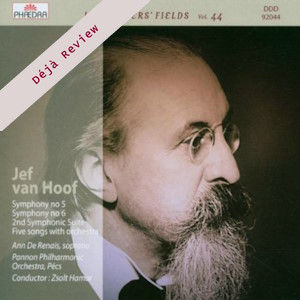
Déjà Review: this review was first published in December 2005 and the recording is still available.
Jef van Hoof (1886-1959)
Symphony No.5 in E minor (1954)
Five Songs
Second Symphonic Suite (1952)
Symphony No.6 in B flat major (1959)
Ann De Renais (soprano)
Pannon Philharmonic Orchestra Pécs/Zsolt Hamas
rec. 2005, Music Hall, Pécs, Hungary
Phaedra 92044 [76]
Jef van Hoof was a much respected and highly regarded Flemish composer with a sizeable output to his credit. Though he composed a good deal of vocal and choral music, the backbone of his output lies in his six symphonies, of which the Sixth is unfinished. All but one can now be had in commercial recordings (the First and Fourth on Phaedra 92013, and the Second on Marco Polo 8.225101 or Naxos 8.554461/2). A recording of the Third, once on Phaedra Mouseion 492001, is no longer available.
Van Hoof had strong views as to what music (his music) was to be. “The composer wants his music to sing with inner dramatic tension; expression must have the power of austerity, melody must grip the hearer directly” (van Hoof quoted in Luc Leytens’ excellent notes). Though he roughly belonged to the same generation as Bartók, Stravinsky, Kodály and Prokofiev he stuck fast to great classical symphonic principles. He deliberately chose to express himself in a warmly lyrical late-Romantic language. He adhered to this throughout his career, as the late symphonies recorded here amply show. There are very few traces of Impressionism in his music. It remains deliberately, almost stubbornly, indebted to Romantic models. What may distinguish it from its most obvious models, is the clarity of the orchestration and its straightforward expressive range. The Scherzos of the Fifth and the Sixth Symphonies have an earthy, peasant-like quality reminiscent of folk song, although he rarely quotes any, in his symphonies at least. His music also displays irony or humour, even black humour, as is clearly heard in his Second Symphonic Suite of 1952.
The Symphony No.5 in E minor, completed in 1954, is in four movements laid-out in the traditional pattern, with a short Scherzo placed third. Van Hoof’s lyrical gifts are particularly evident in the beautiful slow movement.
Composed two years earlier, the Second Symphonic Suite is lighter in mood, and displays irony and humour (e.g. in the third and fifth movements). The deeply-felt hymn-like fourth movement, scored for strings, displays van Hoof’s mysticism, and the second movement his compassion “for one that must live with a limp”. Some of the movements have autobiographical connotations, e.g. the opening movement White Slacks (the composer used to wear white slacks when on holiday at the seaside, where the suite was actually written) and the fourth movement (Better I).
The Symphony No.6 in B flat major was left unfinished at the time of the composer’s death. The first three movements were fully scored but van Hoof had only scored the first three bars of the Finale, an assertive brass fanfare playing for ten seconds. It is (or – rather – should have been) in four movements of broadly equal length. Though for standard symphony orchestra, the scoring is much lighter, more transparent. Had the Sixth Symphony been completed, it might have been van Hoof’s Sinfonia Semplice.
The five orchestral songs recorded here date from various periods of van Hoof’s composing life. The earliest (’t Is Stille, on words by Guido Gezelle) dates from 1903 whereas the most recent (De Lotusbloem) was completed as late as 1957. Slaaplied (“Lullaby”, again on words by Gezelle), Nachtdeun (“Night Song”) and Suja, nu Suja! date from 1910, 1924 and 1930 respectively. All of them are fairly clearly modelled on the songs of Duparc and Fauré. They are all straightforward, beautifully written for the voice and subtly scored; and often quite moving in their apparent simplicity.
Full marks to all concerned for playing and singing such unfamiliar stuff with so much commitment and conviction. If you know any of van Hoof’s music, you will know what to expect, although the beautifully moving simplicity of the songs and the varied expressive nature of the Second Symphonic Suite might pleasantly surprise. All in all, a really lovely release that I warmly recommend to all who relish beautifully crafted, colourful and tuneful late-Romantic music.
Hubert Culot
Availability: Bandcamp


















